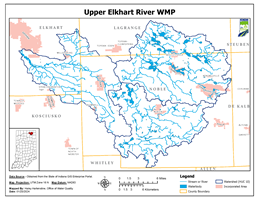Summary
Elkhart River Restoration Association (ERRA) received a 319 grant in 2021 from the Indiana Department of Environmental Management (IDEM) to write a Watershed Management Plan (WMP) for the Upper Elkhart River watershed. The Upper Elkhart River Watershed drains 403 square miles in Elkhart, LaGrange, Steuben, DeKalb, and Noble counties. The watershed includes drainage from The Towns of Wolcottville, Millersburg, Rome City, Albion and Cromwell and Cities of Ligonier and Kendallville. The watershed includes three 10-digit hydrologic unit codes (HUCs): 0405000115 (North Branch Elkhart River), 0405000116 (South Branch Elkhart River) and 0405000118 (Solomon Creek).
The Upper Elkhart River Watershed includes a variety of land uses including agricultural, forest and natural areas, including nature preserves local parks, as well as urban and urbanizing land uses. Much of the watershed is dominated by agricultural land use with intact forested riparian areas especially adjacent to the mainstem of the Elkhart River. Urban and urbanizing land is found adjacent to the many watershed lakes and in its cities and towns including the Cities of Ligonier and Kendallville and Towns of Wolcottville, Millersburg, New Paris, Rome City, Albion and Cromwell. The mix of land uses generates a variety of concerns including: nutrient, sediment and pathogen runoff; flooding and loss of floodplain impacts; fish community impacts; algal blooms in watershed lakes and streams and more.
Several water quality impairments were identified during the watershed inventory process including elevated nutrient, sediment and E. coli concentrations. The approved WMP includes goals to reduce the pollutant loading of nitrogen by 1,079 tons/year, phosphorus by 9.27 tons/year, and sediment by 868,590 tons/year. E. coli loading should be reduced from 5.51E+14 to 4.50E+14 The overall project progress will be tracked using the action register as a guide for the schedule of activities to be completed throughout the future. The Upper Elkhart WMP was approved by IDEM and US Environmental Protection Agency in January 2024.

